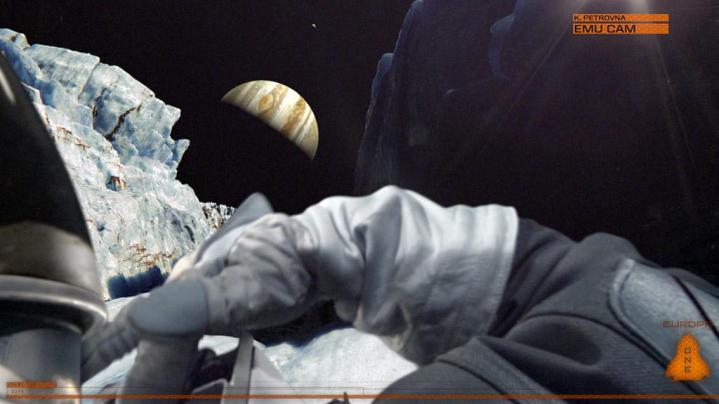
At a time when most “science fiction” movies tend to sacrifice science for fiction in the pursuit of mainstream appeal, Europa Report offers a welcome reminder that a great sci-fi story need not always be the effects-driven, explosion-filled, alien-fighting spectacle we’ve grown accustomed to in recent years.
Directed by Ecuadorian filmmaker Sebastian Cordero, Europa Report tells the story of six astronauts on a mission to Europa, one of the moons of Jupiter, on a search for signs of life beneath its frozen surface. The trip is a long one — lasting several years — and along the way they lose one of their crew members as well as their communication link with Earth. The film chronicles the crew’s difficult journey to Europa and the surprises that await them when they finally arrive. Among the film’s cast is District 9 star Sharlto Copley, Embeth Davidtz (Army of Darkness), and Michael Nyqvist (The Girl With The Dragon Tattoo).
Filmed in a found footage style, the story unfolds through the lenses of cameras positioned throughout the spacecraft, as well as archival footage featuring both fictional scientists and real-world experts in the field (including well-known astrophysicist Neil deGrasse Tyson). At times, the line between the fictional world of Europa Report and the real-world investigation is blurred, with the film taking care to present what we actually do know about Europa — long believed to be the most likely place we’ll find evidence of life outside Earth — and the actual logistics of what it would take to get there. The result is a tense adventure about a small group of explorers’ search for life on a faraway moon. It reminds its audience just how exciting (and dangerous) the act of discovery can be.

Digital Trends spoke with Cordero about the film and the fresh approach it takes to science fiction storytelling, as well as the technical elements that made it such a unique filmmaking experience.
The movie doesn’t glamorize space travel in the way so many science fiction films seem to, and doesn’t shirk away from presenting those long stretches of travel time, the claustrophobic environment, and all the technical jargon that goes along with something of this magnitude. Was that something you made a conscious effort to portray? The realities of extended space travel?
Yes. Absolutely. It’s one of the things I felt was working very well to begin with in the script when I first read it, and it was one of the things I found very appealing. [The script] managed to find a really good equilibrium between telling a gripping story without needing to sacrifice realism or sacrifice what it was to travel in space. And yes, presenting all of that took a few, very specific moments that we dwell on — the length of the travel, some of the difficulties, and like you mentioned, some of the technical elements. But I felt that [those moments] were going to enrich the world we were portraying.
“[The script] managed to find a really good equilibrium between telling a gripping story without needing to sacrifice realism or sacrifice what it was to travel in space.”
It was interesting, because when I first read the script I thought it would be really cool to design this ship and be able to actually shoot from several angles simultaneously and the minute I started working with Enrique Chediak, the cinematographer, and Eugenio Caballero, the production designer, we realized that what originally seemed like a good idea was actually the only way to make this work. We had a very short shooting schedule. At one point, we realized that if we got as many cameras in there as possible — and we managed to get eight in there — and shoot simultaneously with all of them, it would allow us to actually be able to shoot complicated scenes from all our different angles at the same time, and would be an incredibly immersive experience for the actors.

So the actors were basically working inside a box?
Once the actors were in the set, there was no one else inside besides them. All the lighting came from the practical lighting inside the ship, the actors were miked, and there were microphones in different parts of the ship, too. It allowed us to play each scene almost as if it was a performance for all of these cameras. It was really interesting. The characters they’re playing know they’re being filmed, and that the journey is being monitored and documented, so we played with that a bit. Some of the characters are more aware of the cameras, and some are less aware. They were very subtle things, but things that would add to the realism. And yes, it was a claustrophobic set. It’s funny because I think when you watch it through the wide-angle lens that these cameras are capturing everything from, it looks bigger than it actually was. [Laughs]
What was it like for you, though? As a director, having that wall between you and what’s happening in a scene can’t be easy to deal with…
It was such a unique experience to shoot like this. For the actors, it was terrific, but for me it was difficult. I was basically directing from the outside, through a microphone and looking at all of these random monitors. It was like I was Mission Control.
The movie seems remarkably well-researched as far as the science at play in both their mission and the events that transpire along the way. Did you receive some input from astronauts or other people involved with the space program in some capacity? What sort of research did you do?
“I was basically directing from the outside, through a microphone and looking at all of these random monitors. It was like I was Mission Control.”
In a film like this, you have to find the proper balance what to reveal and what to tease, as well as how you want to dole out information over the course of the story. There are points in the movie when I wasn’t entirely certain where things were headed, despite all of the information leading up to that point. How did you find that balance as a filmmaker between what you show the audience and what you simply hint at?
On one end, I completely agree with you, and you aren’t supposed to know where things are going, but at the same time, there’s a lot set up early on. You know that something went wrong with the mission and we’re watching this footage, so the footage obviously made it back to Earth somehow. So how did it get there? How are we watching this? There’s a lot of suspense in getting to that point. There’s also this 10 Little Indians structure to the story, with the characters gradually disappearing one by one, and that’s a great source of tension. You know there’s danger, but it’s not the typical danger you’re used to in science-fiction movies. This is a story about finding life somewhere else, but it’s not about that form of life coming down and hunting them one by one. No, it’s more about the scientific approach and the dangers involved in the scientific approach and their journey. That was fun to play with.

What about how the story is presented chronologically? It jumps around a lot in time as we’re given pieces of the story…
We developed that element during the post-production process and editing — that nonlinear structure of the film. Originally, the script as it was written was chronological. We put that chronological version together, but that tension we’ve been talking about wasn’t as strong. It played differently. The way you were introduced to each character felt different, too. Right now, each character is introduced in a moment of crisis and it’s easier to put yourself in their shoes. It’s something we started experimenting with in the editing room, and we realized there was no reason we needed to make it chronological. We just found a structure that we felt did the best for the storytelling and the tension.
You mentioned this before, but working in science fiction is certainly new ground for you. What was it like to shift gears so dramatically and work on a project like this?
I had never worked on anything close to this at all, but growing up I was a big sci-fi reader. More than actually watching sci-fi films, I loved reading science-fiction. Anything from Arthur C. Clarke to Ray Bradbury and Philip K. Dick, I was devouring them as a teenager. When I was making films, I had a lot of interest in that world, but it was something so distant from what I had access to that it never even occurred to me to explore that possibility. But then this script came along my way and I’m very grateful to the producers for thinking of me for this. I was not the typical choice for this, but I was absolutely passionate about it from the start, and I think they saw that passion and what I would bring to the project.
Europa Report opened August 2, 2013 in limited release. It’s available now via Video on Demand, iTunes, and Google Play Movies.




